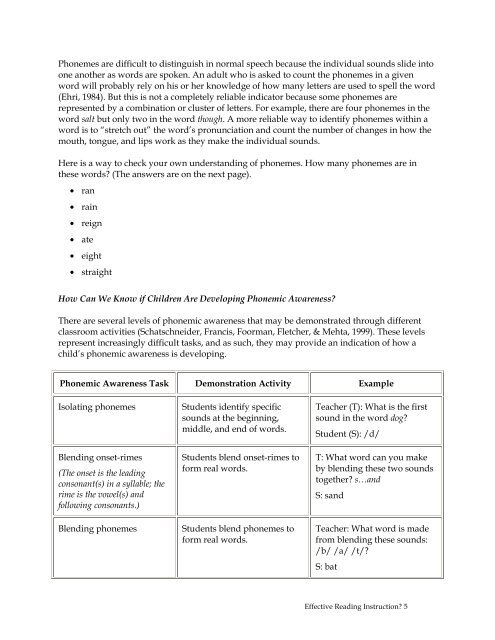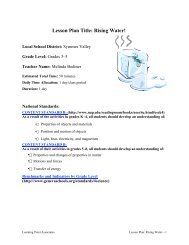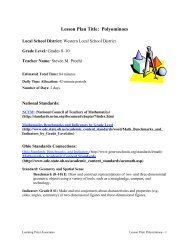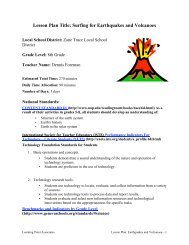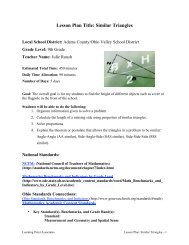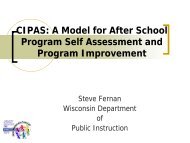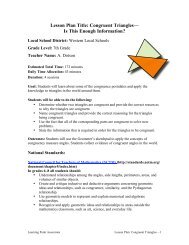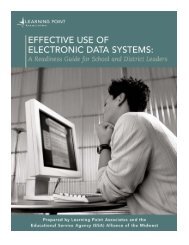A Closer Look at the Five Essential Components - Learning Point ...
A Closer Look at the Five Essential Components - Learning Point ...
A Closer Look at the Five Essential Components - Learning Point ...
You also want an ePaper? Increase the reach of your titles
YUMPU automatically turns print PDFs into web optimized ePapers that Google loves.
Phonemes are difficult to distinguish in normal speech because <strong>the</strong> individual sounds slide into<br />
one ano<strong>the</strong>r as words are spoken. An adult who is asked to count <strong>the</strong> phonemes in a given<br />
word will probably rely on his or her knowledge of how many letters are used to spell <strong>the</strong> word<br />
(Ehri, 1984). But this is not a completely reliable indic<strong>at</strong>or because some phonemes are<br />
represented by a combin<strong>at</strong>ion or cluster of letters. For example, <strong>the</strong>re are four phonemes in <strong>the</strong><br />
word salt but only two in <strong>the</strong> word though. A more reliable way to identify phonemes within a<br />
word is to “stretch out” <strong>the</strong> word’s pronunci<strong>at</strong>ion and count <strong>the</strong> number of changes in how <strong>the</strong><br />
mouth, tongue, and lips work as <strong>the</strong>y make <strong>the</strong> individual sounds.<br />
Here is a way to check your own understanding of phonemes. How many phonemes are in<br />
<strong>the</strong>se words? (The answers are on <strong>the</strong> next page).<br />
• ran<br />
• rain<br />
• reign<br />
• <strong>at</strong>e<br />
• eight<br />
• straight<br />
How Can We Know if Children Are Developing Phonemic Awareness?<br />
There are several levels of phonemic awareness th<strong>at</strong> may be demonstr<strong>at</strong>ed through different<br />
classroom activities (Sch<strong>at</strong>schneider, Francis, Foorman, Fletcher, & Mehta, 1999). These levels<br />
represent increasingly difficult tasks, and as such, <strong>the</strong>y may provide an indic<strong>at</strong>ion of how a<br />
child’s phonemic awareness is developing.<br />
Phonemic Awareness Task Demonstr<strong>at</strong>ion Activity Example<br />
Isol<strong>at</strong>ing phonemes Students identify specific<br />
sounds <strong>at</strong> <strong>the</strong> beginning,<br />
middle, and end of words.<br />
Blending onset-rimes<br />
(The onset is <strong>the</strong> leading<br />
consonant(s) in a syllable; <strong>the</strong><br />
rime is <strong>the</strong> vowel(s) and<br />
following consonants.)<br />
Students blend onset-rimes to<br />
form real words.<br />
Blending phonemes Students blend phonemes to<br />
form real words.<br />
Teacher (T): Wh<strong>at</strong> is <strong>the</strong> first<br />
sound in <strong>the</strong> word dog?<br />
Student (S): /d/<br />
T: Wh<strong>at</strong> word can you make<br />
by blending <strong>the</strong>se two sounds<br />
toge<strong>the</strong>r? s…and<br />
S: sand<br />
Teacher: Wh<strong>at</strong> word is made<br />
from blending <strong>the</strong>se sounds:<br />
/b/ /a/ /t/?<br />
S: b<strong>at</strong><br />
Effective Reading Instruction? 5


